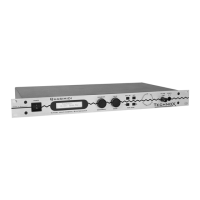12
8.) Editing the effects
8.) Editing the
effects
TECHNOX offers two independent effect-processors with various algorithms. For each part the amount
of FX1 and FX2 can be changed by the effect sends. For editing the effects there are two main-menus: One
for all parameters of FX1 and the other for FX2. You can reach them by pressing the “EDIT/OK”-button
and using the “PARAMETER/SOUNDGROUP”-dial. The first parameter in both of the main-menus is
the type of effect. Each effect has different menu-pages depending on the algorithm you have chosen. The
following table gives you an overview about all algorithms:
Room-simulation FX-1 Special-effects FX-2
1.) Room 1.) Chorus 1
2.) Small Room 2.) Chorus 2
3.) Warm Room 3.) Chorus 3
4.) Chamber 1 4.) Flanger 1
5.) Chamber 2 5.) Flanger 2
6.) Plate 1 6.) Phaser 1
7.) Plate 2 7.) Phaser 2
8.) Hall 8.) Panning
9.) Large Hall 9.) Short-Delay
10.) Cathedral 10.) Long-Delay
11.) Gated Reverb 1 11) HQ-Delay
12.) Gated Reverb 2 12.) Ping-Pong
13.) Gated Reverb 3 13.) Gated-Delay
14.) Early Reflection 1 14.) Special FX
15.) Early Reflection 2 15.) Equalizer 1
16.) Early Reflection 3 16.) Equalizer 2
17.) Early Reflection 4 17.) Wah Wah + Overdrive
18.) Raindrops 18.) Auto Wah Wah
19.) HQ-Delay 19) Warm Overdrive
20.) LongDelay 20) Distortion
21.) no Effect 21) no Effect
To understand how the two effect processors can influence each other, take a look at the following schematic:
QUASIMIDI STYLEDRIVE FANSEITE
http://people.freenet.de/styledrive/

